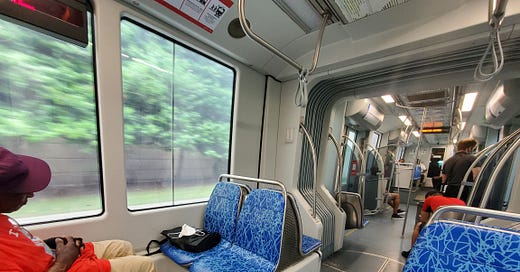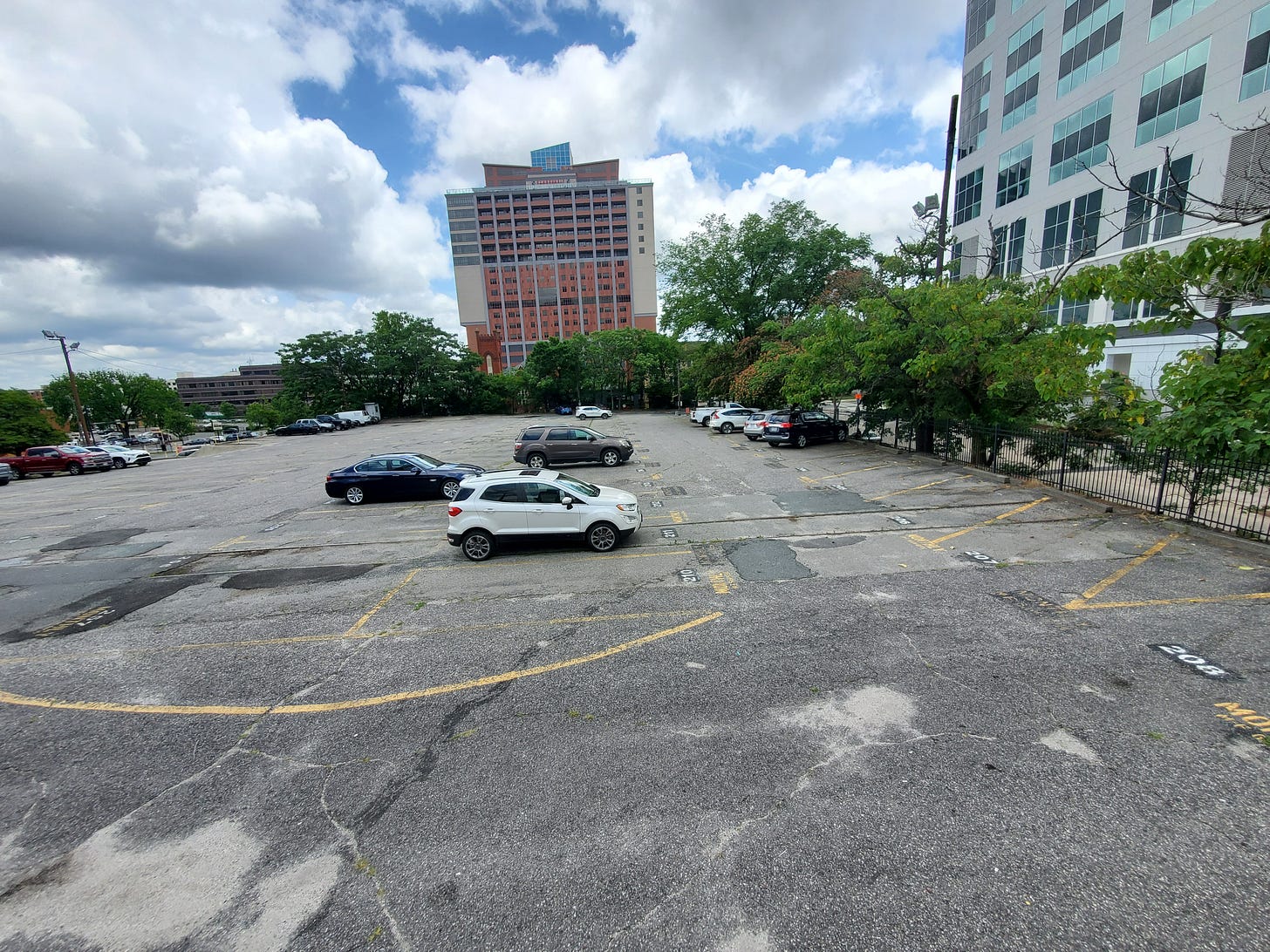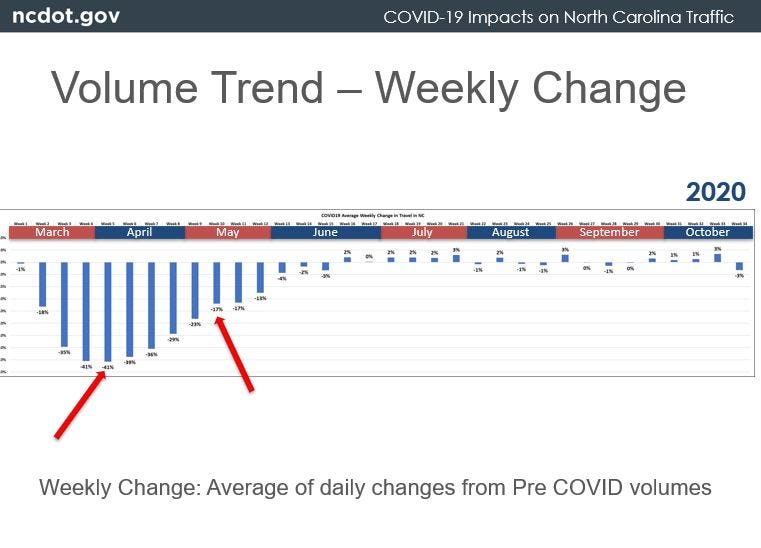You’re reading Transit Time, a weekly newsletter for Charlotte people who leave the house. Cars, buses, light rail, bikes, scooters … if you use it to get around the city, we write about it. Transit Time is produced in partnership among The Charlotte Ledger, WFAE and the UNC Charlotte Urban Institute.
Editor’s note: This issue of Transit Time is being sent to all Charlotte Ledger subscribers. If you’d prefer not to receive future editions of this newsletter, you can adjust your preferences on the ‘My Account’ page.
While travel by car and plane has rebounded quickly, Charlotte’s light rail and bus trips inch upward; still down 60% from pre-pandemic
CATS carried more passengers in April 2021 than April 2020. But traffic is still down 60% compared with April 2019.
by Steve Harrison
We now have our first look at transit ridership’s post-Covid recovery — and a sense of how far the Charlotte Area Transit System has to go.
Here are the numbers:
In April 2019, CATS handled 1.8 million passenger trips. The Lynx Blue handled just under 690,000 of those. The bus system carried the rest.
Fast-forward to April 2020 — the first full month of the county and state’s semi-lockdown.
That month CATS traffic fell to just under 594,000 trips. That’s a 2/3 drop.
CATS recently tabulated transit ridership for April 2021 — the first time we can compare what post-pandemic life may be like after the state and businesses started really easing restrictions.
For that month, CATS says it handled 721,500 passenger trips. That’s a 21.5% increase over the previous year, but still only 40% of the traffic from the comparable pre-pandemic month, two years earlier.
(It should be noted that 2019 wasn’t Charlotte transit’s peak. That was in 2014, when CATS carried 29.4 million trips. Ridership had already fallen by 18% from 2014 to 2019, even with the opening of the $1.1 billion Lynx Blue Line extension.)
Is work from home here to stay?
April 2021 is arguably a transition month.
Vaccines were just becoming widely available, although most uptown businesses were still allowing work from home. Bars and restaurants were pretty full, but Gov. Roy Cooper’s mask mandates were still in effect.
As ridership numbers for the summer are tallied, it’s likely traffic will keep climbing as life returns to normal.
But how long until CATS reaches 2019 passenger levels? And will it ever?
A trip on the Blue Line: I rode the Lynx Blue Line Tuesday afternoon through uptown. There were 15 people in my car and a handful of people waiting on the platforms of uptown stations. It wasn’t particularly busy, but the passengers I spoke with said there were more people riding than for much of the pandemic.
Charles and Mary Phillips are retirees from south Charlotte. They love the train and rode it several times — even before vaccines.
“The biggest issue is what happens with work from home,” Charles Phillips said about the future. “That’s going to be very important.”
Not back to the office yet: an uptown parking lot at 2:30 p.m. on Tuesday.
The work from home issue is indeed critical to transit’s success.
Earlier this spring, Duke Energy announced it would be consolidating its uptown workforce into a new skyscraper under construction on South Tryon Street. The move will shrink the company’s footprint by 60%.
The accounting firm Grant Thornton has said it’s moving from uptown to South End. It will also use less space — a sign that work from home will continue.
What about other modes of transportation?
Driving across the nation and in North Carolina is nearly back to pre-pandemic levels.
Vehicle traffic plunged during the early days of the pandemic but has since bounced back.
During lockdown, airlines were hurt even more than transit.
In April 2019, Charlotte Douglas Airport handled 2.07 million passenger enplanements.
That fell to just under 170,000 in April 2020, the first full month of the pandemic.
But a year later, it’s almost back to normal, despite a steep drop in international service. CLT handled 1.9 million enplanements in April 2021.
That’s the classic “U shaped curve” of a rapid economic recovery.
CATS is experiencing a more gradual comeback — for now, it’s looking more like a backwards J.
Steve Harrison is a reporter with WFAE, Charlotte’s NPR news source. Reach him at sharrison@wfae.com.
In brief…
Charlotte streets called ‘disordered’: A 2019 study on cities’ street layouts got some new life on social media in the last week — and it shows that Charlotte has one of the most disorganized street patterns of the 100 cities studied. The study found Charlotte’s streets to be “nearly perfectly disordered” and said: “Sprawling, high-entropy Charlotte is in a separate cluster (alongside Honolulu) dominated by cities that developed at least in part under the auspices of twentieth century communism, including Moscow, Kiev, Warsaw, Prague, Berlin, Kabul, Pyongyang and Ulaanbaatar.” A UNC Chapel Hill urban planning professor told WCNC that having an imperfect street grid doesn’t make a city less drivable. “Charlotte is always called out in planning circles as one of the cities that is most advanced in how should we design and even redesign our streets so that they work for everybody in the community,” he said. (WCNC)
Worst Charlotte driving spots: Axios Charlotte compiled a list, crowdsourced from readers, of nine Charlotte driving locations that are pet peeves. The list includes Exit 3A off I-277 to NoDa (“no idea who created that insanity”); Central Avenue street parking that clogs traffic in Plaza-Midwood; the intersection of West Tremont Avenue and Camden Road by the Rail Trail in South End, where “scooters, runners, cars and trains … all come together”; and “South Boulevard, in general.” (Axios Charlotte)
Transit money to be redirected: The Charlotte Area Transit System said the federal government has granted permission for it to spend $30.3M in cost savings from the Lynx Blue Line Extension on “future light rail reliability and safety improvements.” The money might be used on projects including a new light rail station in South End, buying 14.9 acres to expand CATS’ North Rail Yard and improving storm drains along the light rail line, CATS said. (CATS)
Speeding crackdown on I-485: Police issued 421 traffic citations in a four-day crackdown on I-485 before Labor Day, according to a Charlotte Observer analysis. The figure includes 190 drivers going 86 mph or faster. An investigation by the paper found that extreme speeding has increased since the start of the pandemic. (Observer)
Free transit ride, with bike: CATS is offering free rides through Saturday for people who take their bikes on buses or light rail. Details.
Unusual bicycles on display: A special exhibition at the N.C. Transportation Museum in Spencer, 45 miles northeast of Charlotte, showcases more than 30 “extraordinary bicycles.” “Visitors will see early antiques, avant-garde ‘mutant’ bikes and innovative machines that truly exemplify the unconventional history and people of the eccentric world of cycling,” WBTV reported. The exhibit runs through Sept. 5.
Transit Time is a production of The Charlotte Ledger, WFAE and the UNC Charlotte Urban Institute.
Did somebody forward you this newsletter and you need to sign up? You can do that here:
Other affiliated Charlotte newsletters and podcasts that might interest you:
The Charlotte Ledger Business Newsletter and Ways of Life newsletter (obituaries), available from The Charlotte Ledger.
The Inside Politics newsletter, available from WFAE.
The UNC Charlotte Urban Institute newsletter and the Future Charlotte podcast from the Urban Institute.









